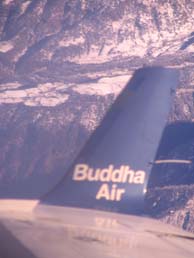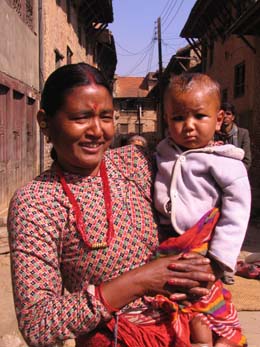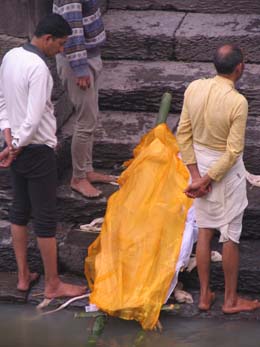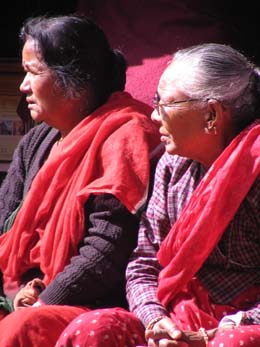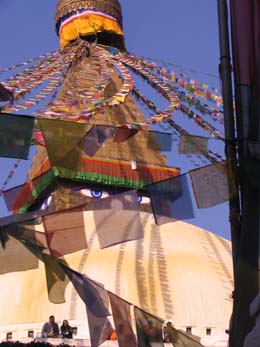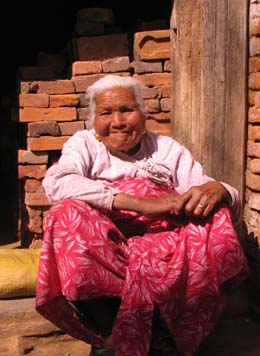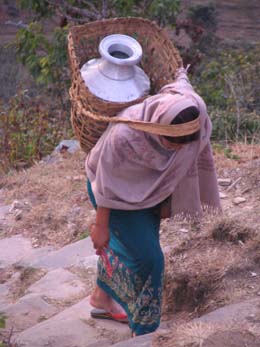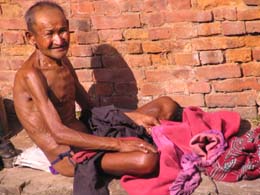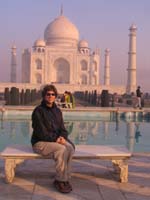Nepal:
A World Away I survived a bloodless royal coup in Nepal. But let me assure you that this sounds more heroic than it was. On February 1, 2005, the day after I landed in the country, the king of the Hindu Kingdom of Nepal sacked the prime minister, fired the cabinet, muzzled the media and cut the phone lines (including of course the Internet). However on this rather significant day, I am staying at the elegant Hyatt Regency Kathmandu and it’s business as usual. A state of emergency has been declared, but nonetheless my tour guide and driver are waiting to show me the villages of the Kathmandu Valley. |
|||||
|
|
|||||
Did you know? Nepal — a country with a population of 22 million, of which 80 per cent are farmers — has the densest concentration of Unesco World Heritage sites in the world. And, as I discover, this small country has never been colonized. Perhaps this strange state of affairs explains in part the almost surreal serenity that is pervasive on this day when the supreme ruler of the people of Nepal has seized control of the democratically elected government that has ruled for 15 years. This is just the latest but perhaps most dramatic move on the part of the government; but it is certainly not good public relations for this tiny nation. American tourism, for example, has dropped over the past few years as the U.S. State Department has issued travel warnings against the country as a result of violent Maoist activity — although no tourists have been harmed in the insurgency. Truth is, I feel safe while I am in Nepal, whether I am walking the crowded streets of Kathmandu (a city of 2.5 million), the exquisitely preserved villages of the surrounding valley, or the tourist-friendly city of Pokhara, which is also the jumping off point for trekkers from around the globe. In fact, the country is still much safer than most U.S. cities. A matter of perspective In Nepal and in the towering shadow of the snow-covered Himalayas, you will find some of the best walking trails on Earth with the most breathtaking scenery. And the people are living focal points in that scenery. I am particularly taken with the distinctive Nepalese faces here: browner, flatter, broader and with higher cheekbones than in neighboring India, where I’ve spent the preceding month. As I take picture after picture of individuals passing by, I try to capture and thus express the pride and elegance of the people's distinctive Asian features, features in which I also see traces of Mongolian and Tibetan heritage. Dakshinkali is a temple dedicated to Kali, the Hindu goddess of destruction. On the auspicious days of Tuesday and Saturday, animal sacrifices are made in thanks to the goddess for prayers that have been answered. Standing in line, young children in neat school uniforms clutch writhing chickens. Men lead tethered goats. A few women hold coconuts, which are offered in lieu of animals. When they reach the temple, “professionals” make one quick, practiced slice — and in a swift instant the animal’s head is placed on the altar. The rest of the animal is then butchered, dressed and returned to the family. The ritual flows like the blood of the animal; incense permeates the air; soft prayers are chanted. And as I am drawn into the scene, I am surprised to find myself sensing something spiritual rather than being repelled by the gruesomeness of the slaughter. Other mesmerizing traditions are practiced in two indigenous Newar villages we visit. Both are heavily terraced with rice fields but without electricity. (Just five per cent of the country’s inhabitants are members of the Newar ethnic group). Walking down the cobbled streets, I see the severed head of a water buffalo — the animal will feed the community for several days. Hay is drying in the sun.Bare-breasted married women are washing clothes at the communal well. Girls braid their mothers’ hair. Men play cards. Old women card wool. Little boys scamper after a dog. It's just an ordinary day in Nepal. I spend the evening ambling the winding streets of downtown Kathmandu. I buy beautiful amber and coral and turquoise jewelry. And then I dine on good Mexican food. Afterwards, I peruse numerous bookstores laden with a great assortment of books either sold or traded by the many backpackers from around the planet who have passed through Nepal completing another kind of ritual. I examine the books carefully, taking my time — I feel no urgency — and finally settle on Everest, the place-appropriate bestseller by John Krakaeur. I take a rickshaw back to the hotel at 11 p.m. The next morning, we drive to Nagarkot, an hour away. Here, I enjoy the best mountain views on the trip — save for the mountain flight I splurge on the following day. Buddha Air offers a one-hour sightseeing tour. The weather has been foggy, but as we climb to 25,000 feet, a palpable sense of awe can be felt in the aircraft. The monumental craggy mountains seem almost close enough to touch. The flight attendant draws our attention to the peaks and then one by one she allows us to move to the front of the plane and peer over the pilot’s shoulder. When my turn comes I move forward, look out, and take in with my eyes and my entire being a straight-on view of Sagarmatha, Nepali for Mt. Everest — “the head of the world.” At Pashupatinath Temple, on the banks of the Bagmati River, I watch as a yellow-swathed body is carried aloft on a stretcher. This is Nepal’s holiest pilgrimage site, a collection of Hindu temples and cremation ghats where ritual bathers and half-naked sadhus (religious men) gather. A woman wails her grief for her dead husband while the attendants — brothers or sons — dip the deceased’s feet into the water one final time before he will make his passage to heaven. The means of his passage will be the wooden funeral pyre waiting nearby. At the thriving arts center called the Tibetan Refugee Camp, established in 1961 by the Swiss and the American Red Cross, women are weaving beautiful rugs and preparations are underway for the Tibetan New Year, just four days away. Stupas in the courtyard are getting a whitewash by the men. Fifteen per cent of the area’s population is Tibetan. The Hyatt where I am staying is a luxurious, 37-acre compound on the edge of town, unlike any Hyatt I’ve ever seen. It is notable for its Nepalese architecture and exterior water and interior temple courtyards, replicas of shrines built in the 11-18th centuries. The staff is so embracing, I feel like a member of the family after a day. From my lovely, graciously appointed room with its gleaming wooden floors, I have a panoramic view of Boudhanath (or Buddha) Stupa, the most holy of Tibetan Buddhist temples outside Tibet. Later at the hotel’s Oasis Spa, the massage therapist, Lahami, pours mountain forest oil into my belly button. I feel a kind of blissful magic. At dusk, I go for a gentle 10-minute walk to the dome-shaped Buddha Stupa, with its painted eyes that rise above the city. Butter lamps flicker. The Tibetan pilgrims are easy to identify as they circle the stupa with red tassels woven into their hair and their traditional woolen striped clothing. They clutch prayer beads, chant mantras and spin their prayer wheels. I fall into the group, and join in the chant of Om Mani Padme Hum. Prayer flags above my head are whipped by the wind that descends from a great height. My feeling of bliss deepens. The next day, my guide takes me to Bhojan Triha for a traditional Nepali dinner. As I enjoy momcha, meat-filled dumplings, mismas tarkari, mixed vegetable curry and mascura, fried, pressed lentils, I watch nimble-footed dancers perform intricate and graceful traditional dances in this restored home which now serves as a restaurant. I sip smoky rum called kakuri, the nation’s ceremonial drink. Lest my family has seen news coverage of the coup on CNN, the following morning, I go to the U.S. Embassy and send an email to family and friends assuring them that all is well and that I am fine, (As it turns out only a few saw any mention of the small country.) The email process takes less than 15 minutes; but this modern form of messaging cannot communicate How “well” and how “fine” I feel. I then visit Swayambhunath, another stupa where the devoted walk clockwise around the massive base of the Buddha, twirling prayer wheels while rhesus monkeys scamper about, begging for food. |
|
||||
In the impressively preserved town of Patan, known as the city of fine arts of Nepal, I am somewhat taken aback by the incongruity of posters advertising Virgin Records, Playboy and Valentine liquors. Along with Bhaktapur, Patan is an open-air museum with numerous palaces, monuments, narrow streets and temples built during the Mala Dynasty that ruled the Valley from 1220 to 1768. In durbar murg (central square), I watch a band leading a procession that culminates with a garlanded car — a wedding party. I have become so transfixed by the meditative chanting at the stupas, that I buy a Tibetan “singing bowl” made of seven layered metals. When struck, its rich sound resonates within me as well as without. Its mystical sound is everywhere and in a sense, so am I. Pokhara is only a 30-minute flight west from the capital Kathmandu. The Annapurna range begins here; it is the country’s second most popular destination. Sadly, cancellations have left my hotel, the lovely Shangri-La, with only seven guests. The staff huddle silently together as if comforting each other in their purposelessness. The Maoists have called for a transportation strike and the locals, fearing reprisal, are honoring it; no taxis, buses, rickshaws or private cars will run during the three days I am here. This is the first time the coup has had a real impact on my movements. So I set off on foot. It’s about a 45-minute walk from my hotel to Lake Phewa, its shoreline studded with shops, hotels, restaurants and travel and trekking agents. The streets of Pokhara, normally swarming with trekkers, today are like those of a ghost town, except for the occasional cow. Some shops are shuttered, notably Internet cafés, and the army presence is everywhere. The armed guards however are happy to give directions; they seem as bored as the hotel staff. A few Tibetan women implore me to look at their trinkets displayed on the sidewalk. Young men and boys drape arms casually over each other’s shoulders. A middle-aged man walks by me wearing a jacket on which is emblazoned the words “rich man.” A skinny yellow dog sleeps on a stoop. A young woman crouches, rigorously cleaning tea glasses with a frayed gray rag. I see several men in doorways, hunched over circa-1950s sewing machines, sewing embroidered logos onto t-shirts. I buy one with the famous “Buddha eyes” from a boy of perhaps 16. He promises to deliver it to my hotel by 7 p.m. He arrives by 6:45 p.m. At Mike’s restaurant, I tuck into moist apple walnut cake at a small café overlooking the water. Then I hire a boat. In the brightly painted wooden canoe, we slip over the water and I gaze around me looking for something very special; but the distinctive Fish Tail Mountain — the most photographed peak in the range — eludes me, hidden behind thick cloud cover. I am disappointed but something tells me that I will see it one day. Chalkboards outside inviting restaurants advertise nightly, first-run movies like Alexander and Oceans 12. I’d love to see an English language movie, but the hotel has recommended I return by 8 p.m., although no curfew has been established. In darkness, I walk back to the hotel, directed by the shopkeepers who huddle over fires in the cool evening air. Friendly children shout hello or Namaste, the all-purpose greeting often said with hands in prayer position. At the hotel’s gift shop, I purchase a paper maché tray depicting a childlike scene of cows and farmers. Min, a 28-year old father of two whom I hire to accompany me on a hike tomorrow to the World Peace Pagoda, tells me the tray is Mithila art, folk art from eastern Nepal. (Min charges $15 for a half-day trek.) The World Peace Pagoda was built by the Japanese in a forest with a commanding view of the valley. As we walk together, Min and I talk about family, politics, food, religion, TV, work. We laugh, comparing the similarities and differences in our cultures. He tells me that although Nepal is a poor country, life is good for most people. He explains he has built a simple five-room house on his guide salary. “No one is homeless, no one is begging.” When we finally arrive at the top we see other visitors who have come to experience this serene place. Backpacks have been shucked, bodies are stretched out in the grass, soaking up the midday sun. The following morning, I rise in darkness in order to meet Min in the lobby at 5:30 a.m. to catch sunrise at Sarangkot. As I huff my way uphill, a small woman with thick black braids trudges down the same path with a huge aluminum milk container strapped to her back. Women here work hard, carrying all manner of stuff on their backs and heads. Min carries my plastic water bottle while I painstakingly pick my way from stone to stone. At the top of our climb, I stop and breathlessly survey the dawning beauty. Even though Fishtail again refuses to show itself, I feel on top of the world. In addition to being a globetrotting one-woman phenomenon, Suzanne Wright is a consummate wordsmith. With over 15 years of experience in advertising, publishing, sales, marketing and public relations — in both large and small companies — Suzanne has also worked in numerous other industries. A member of the North American Travel Journalists Association, Suzanne also has been fulltime, freelance writer since 2000. Based in Atlanta, she specializes in travel, food and decor subjects. She has an extensive background in magazine publishing. Depending on the week, Suzanne can be found in some of the most exotic destinations on the planet.
© Article and photographs copyright of Suzanne Wright
|
|||||
